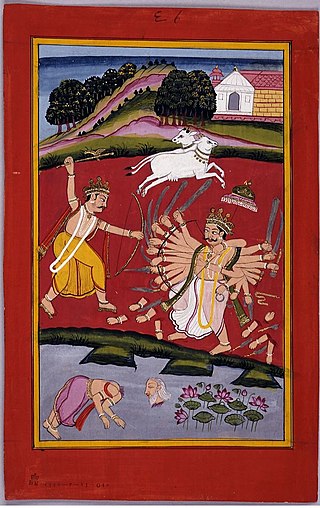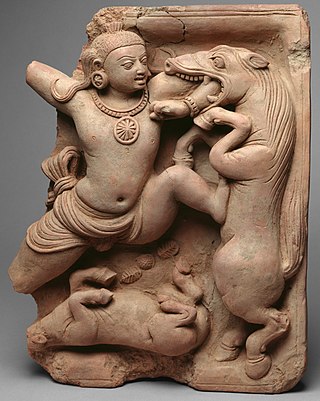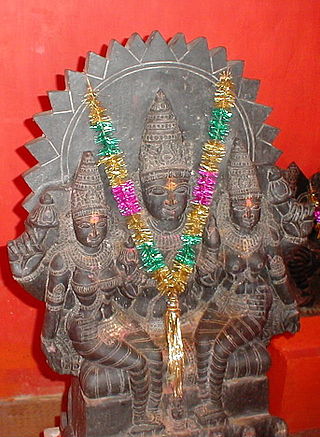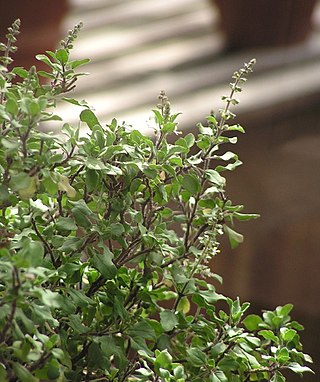
Hindu mythology is the body of myths attributed to, and espoused by, the adherents of the Hindu religion, found in Sanskrit texts such as the Vedic literature, epics like Mahabharata and Ramayana, the Puranas, and mythological stories specific to a particular ethnolinguistic group like the Tamil Periya Puranam and Divya Prabandham, and the Mangal Kavya of Bengal. Hindu myths are also found in widely translated popular texts such as the fables of the Panchatantra and the Hitopadesha, as well as in Southeast Asian texts.

Jamadagni is a sage in Hindu literature. He is regarded in Hindu tradition to be one of the Saptarishi in the 7th, and the current age of Manvantara.

The Yamuna is the second-largest tributary river of the Ganges by discharge and the longest tributary in India. Originating from the Yamunotri Glacier at a height of about 4,500 m (14,800 ft) on the southwestern slopes of Bandarpunch peaks of the Lower Himalaya in Uttarakhand, it travels a total length of 1,376 kilometres (855 mi) and has a drainage system of 366,223 square kilometres (141,399 sq mi), 40.2% of the entire Ganges Basin. It merges with the Ganges at Triveni Sangam, Prayagraj, which is a site of the Kumbh Mela, a Hindu festival held every 12 years.

Subhadra is a figure in Hindu mythology, known for being the younger sister of gods Krishna and Balarama. According to Hindu scriptures, she was a princess from the Yadava clan, who married Arjuna—one of the Pandava brothers—and had a son named Abhimanyu.

In Hindu scriptures, Durvasa, also known as Durvasas, is a legendary rishi (sage). He is the son of Anasuya and Atri. According to some Puranas, Durvasa is a partial avatar of Shiva, known for his short temper. Wherever he goes, he is received with great reverence by humans and devas alike.

Sanjna, also known as Saranyu, and Sandhya, is a Hindu goddess and the chief consort of Surya, the Sun god. She is mentioned in the Rigveda, and also appears in later Hindu scriptures including the Harivamsa and the Puranas.

Revanta or Raivata is a minor Hindu deity. According to the Rig-Veda, Revanta is the youngest son of the sun-god Surya, and his wife Saranyu. Revanta is chief of the Guhyakas, semi-divine and demonic class entities – like the Yakshas – who are believed to live as forest dwellers in the Himalayas. Images and sculptures of Revanta often show him as a huntsman on a horse, with a bow and arrow.

Yama, also known as Kala, and Dharmaraja is the Hindu god of death and justice, responsible for the dispensation of law and punishment of sinners in his abode, Yamapuri. He is often identified with Dharmadeva, the personification of Dharma, though the two deities have different origins and myths.

In Hindu mythology, Keshin, also called Keshi is the horse-demon, killed by Krishna, an avatar of the god Vishnu. The demon was dispatched by Krishna's evil uncle Kamsa, who was destined to die at Krishna's hands.

Chhaya or Chaya is the Hindu personification and goddess of shadow, and a consort of Surya, the Hindu sun god. She is the shadow-image or reflection of Saranyu (Sanjna), the first wife of Surya. Chhaya was born from the shadow of Sanjna and replaced Sanjna in her house, after the latter temporarily left her husband.

Samba was a son of the Hindu god Krishna and his second consort, Jambavati. His foolish prank brought an end to the Yadu dynasty.

Tulasi, or Vrinda is a sacred plant in Hindu tradition. Hindus regard it as an earthly manifestation of the goddess Tulasi; she is regarded as the avatar of Lakshmi, and thus the consort of the god Vishnu. In another iteration, as Vrinda, she is married to Jalandhara. The offering of its leaves is recommended in ritualistic worship of Vishnu and his avatars, like Krishna and Vithoba.

The Ashtabharya or Ashta-bharya(s) is the group of eight principal queen-consorts of Hindu god Krishna, the king of Dvaraka, Saurashtra in the Dvapara Yuga (epoch). The most popular list, found in the Bhagavata Purana, includes: Rukmini, Jambavati, Satyabhama, Kalindi, Nagnajiti, Mitravinda, Lakshmana and Bhadra. Variations exist in the Vishnu Purana and the Harivamsa, which includes queens called Madri or Rohini, instead of Bhadra. Most of them were princesses.

Jambavati is chronologically the second Ashtabharya of the Hindu god Krishna. She is the only daughter of the bear-king Jambavan. Krishna marries her when he defeats her father, Jambavan, in his quest to retrieve the stolen Syamantaka jewel.

Mitravinda is chronologically the sixth of the Ashtabharya of the Hindu god Krishna, an avatar of the god Vishnu, and the king of Dvaraka in the Dvapara Yuga (epoch).

RadhaKrishn is an Indian Hindi-language mythological television drama series that premiered on 1 October 2018 on Star Bharat and is also digitally available on Disney+ Hotstar. After a successful run of more than 5 years, it went off air on 21 January 2023. The series is based on the life of Hindu deities Radha and Krishna. It is produced by Siddharth Kumar Tewary, Rahul Kumar Tewary and Gayatri Gill Tewary for Swastik Productions and is directed by Rahul Kumar Tewary. The roles of Krishna and Radha are played by Sumedh Mudgalkar and Mallika Singh. It completed 1145 episodes and is listed among longest running television series of India and also became the longest ran mythological series. It is also the longest running drama series on Star Bharat to date.

In Hinduism, rivers are often personified as deities. In the Rigveda, there are mentions of holy rivers such as the Sarasvati. The river Ganges is considered to be most sacred, and is personified as the goddess Ganga. Most of the rivers are represented in female form, with the notable exception of Brahmaputra, which is considered to be male. Historically, it is believed that the people of the Indus Valley civilisation worshipped the rivers. The most significant rivers in the faith are the Saptanadi: the Ganges, Yamuna, Sindhu, Narmada, Godavari, Krishna, and Kaveri.

Satrajit (Sanskrit: सत्राजित, romanized: Satrājita), also rendered Satrajita, is a Yadava king in Hinduism. He is the father of the goddess Satyabhama, Krishna's third wife. He is described to be a great devotee of Surya, the sun god. He is known for his role in the legend of the Syamantaka jewel.





















